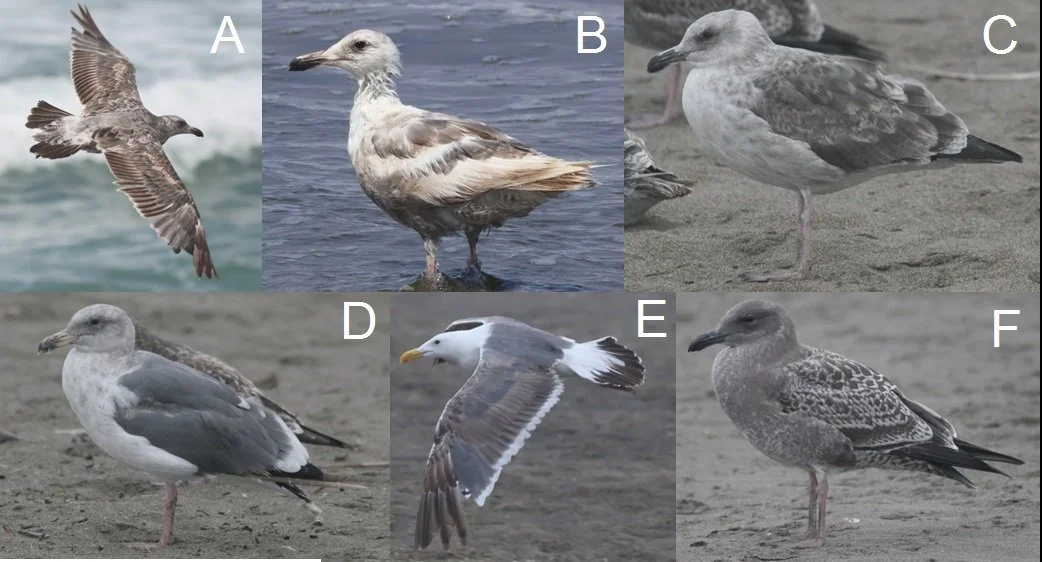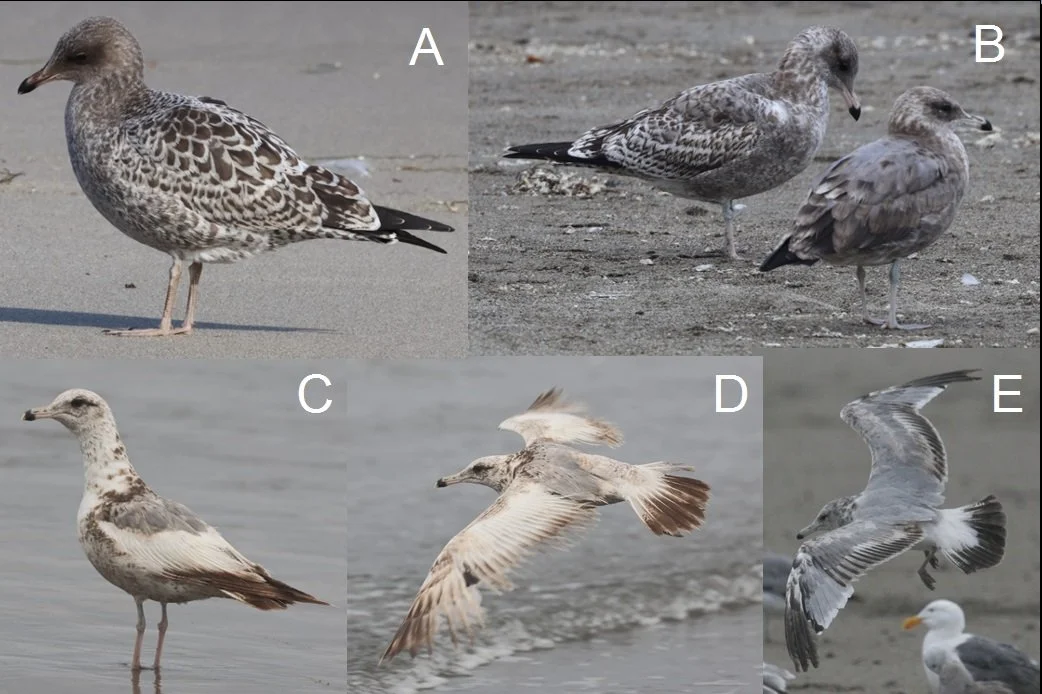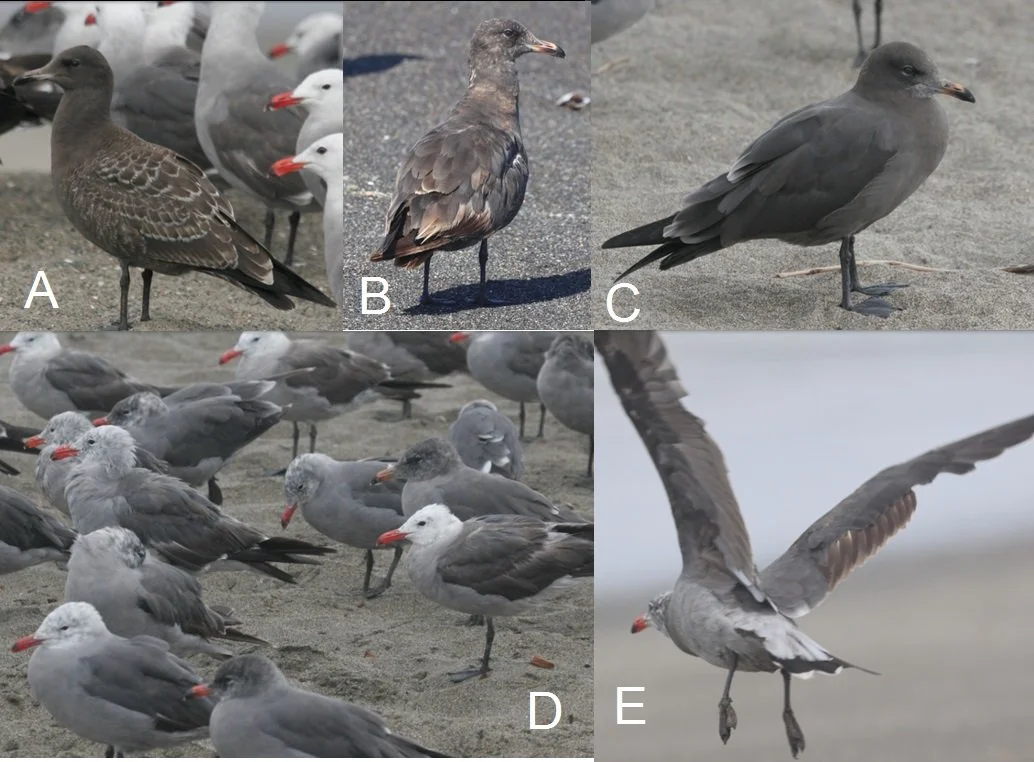Mendo Gulls, Part 2: July - September
This is the second in a series of gull identification and ageing along the Mendocino coast. See the May issue of the Oystercatcher [link] for an introduction to this series. As before, all photos were taken along the central coast from San Francisco to Mendocino County.
You may not think it, but July-September is my favorite time to look at gulls as they are trashed, in molt, changing plumages, and just plain fun. Along our coast >99% of gulls are of three species, so we will cover those in the captions below.
Recall from Part 1 that you should continue studying our common local species, Western Gull, to learn its size, structure, plumage, and changes in bill coloration with age. Knowing Western and California gulls well will greatly help you identify other species as they arrive in mid-to-late fall. In June-August I like to age gulls as 1-year-olds, 2-year-olds, etc., to be precise, as placing them into cycles can be confusing and cause overlap for birds in molt.
Figure 1. Non-adult Western Gulls (WEGUs) in July-September.
I am not showing an adult as these look remarkably the same, year-round, and I hope you know an adult WEGU when you see one by now. For younger birds, similarity in plumage is decidedly not true, due to variation in molting extents and rates, along with poorly understood interactions between molt and plumage deposition cycles.
For example, the birds in A (13 July) and B (7 July) are both 1-year-olds. Some do not get too worn and can still look dark (A) while others can become bleached and trashed (B). Primaries molt outwardly, from innermost p1 to outermost p10, and note in A that replacement has reached p6 (which is growing) and p7 (dropped). For those of you dying to know, we call this the second prebasic molt, with p1-p5 second basic primaries and p8-p10 retained juvenile primaries.
Many of us (myself included) might think that the bird in B is a hybrid with Glaucous-winged Gull (GWGU) but it is simply a WEGU with very bleached primaries. You can tell this by the very dark color of the incoming back feathers. GWGUs and hybrids do occur here rarely in summer, the former being very white (see images in Part 1 [link]), while hybrids can be similar to the bird in B but the incoming back feathers are shaded paler, halfway in between those of WEGU and GWGU.
The bird in C (3 September) is a 1-year-old that has completed molt and has entered its second cycle. It is brown like first-cycle birds, but note the messier look to the upperparts than in juveniles (F). The head is also whiter through the fall than in first-cycle birds. Note the black, freshly-molted, second-basic primaries. The bill color is mostly entirely black in 1 and 2-year-old WEGUs vs. that of CAGU (Figure 2).
The bird in D (also 3 September) is a 2-year-old, entering its third cycle and gaining the plumage of an adult, but retaining brown in the head, black in the tail (usually a band or series of spots), and a bill that is ‘muddy’, black with a pink or yellow base. Note the worn outermost primary yet to be molted.
The bird in E (4 August) is either a 2-year-old or a 3-year-old (entering its fourth cycle), as, by this age, these two groups can overlap in plumage and other features. The brown coloration of the unmolted wing feathers and extensive black in the tail suggest the former, but the adult-like bill color suggests the latter. Note that the molted inner primaries are also adult-like, with the tip of the growing p5 with a black band in a white tip.
I show a juvenile (F, 27 August) last because we don’t usually see these fledged and about here until around this date. They are darker than juvenile CAGUs, with checkered wing coverts that are typically darker and less distinct than those of juvenile CAGUs. Note also the dark pink legs and, importantly, a larger bill that is entirely black.
Figure 2. Non-adult California Gulls (CAGUs) in July-September.
Typically, we do not see many adults or 3-year-old CAGUs here in summer, so we will concentrate on younger birds. We will start this time with juveniles, as they appear 1-2 months earlier than juvenile WEGUs; e.g., the juvenile in A was already out on Virgin Creek Beach on 7 July.
Very early juvenile CAGUs can have dark bills, as in A, but by late August (when juvenile WEGUs fledge) they have bright pink bases, as on the left-hand bird in B (29 August). In plumage, they can be as dark as juvenile WEGUs (other juvenile CAGUs are paler or even peach-colored), but on these darker CAGUs note the paler checkering to the wing and the paler pinkish legs than in the juvenile WEGU in Figure 1F.
One-year-old CAGUs (C and D, 13 July) usually have very bleached wing coverts, a carryover from their being 1-2 months older and the coverts being paler to begin with than those of WEGU. The bill is pale pink to yellow at the base with a distinct black tip, a pattern atypical of WEGUs at any age. In D, note the proportionally longer wings than in the WEGUs (Figs. 1A and 1E), an important identification feature for flying birds, even those far away, with experience.
Something like 85% of our CAGUs in July are 1-year-olds, and when these have completed or near-completed their molt and have entered their second cycle, as in the right-hand bird in B (29 August), they can show some adult-like gray in the back, something we don’t see in 1-year-olds or second-cycle WEGUs at this point. As in WEGU, note also the muddier wing coverts at this age than in juveniles.
The bird in E (21 July) is a 2-year-old, of which we see only a few in summer here. The back has more gray than the 1-year-olds, and the bill and legs are usually bluish to greenish, a unique color for any of our gulls at any age. This bird has molted in adult-like p1-p6, whereas the unmolted p8-p10 are broader, darker, and not as trashed as the retained juvenile feathers of 1-year-olds at this time, as in D. The tail feathers have yet to molt but will come in whiter, usually with black markings or a band.
Figure 3. Heermann’s Gulls
I haven’t mentioned this “summer gull” yet, as they are relatively easy to identify. They follow the pelicans and anchovies up our coast in late June and July and are present here until late October or November, sometimes later during warm-water years. In all plumages, note the black legs and dark underwings, not found in our other gulls, and a bill color that uniquely turns from deep pink to brick red with a broad dark tip as 1 and 2-year-olds, to bright red with a small black tip in adults.
Juveniles (A, 15 July) can arrive early, although in some years there are few or none, following poor breeding seasons where they nest in Mexico. They are chocolate brown with pale fringing to upperpart feathers, creating a scaly appearance. As 1-year-olds (B, 1 July), they molt out the juvenile feathers, by this time very bleached by the Baja CA sun, into a dusky gray plumage, as in C (10 September). They keep this plumage until returning as 2-year-olds in June-July, but by then, it is browner with wear.
Adults return in alternate plumage, with white heads (as in the birds with the juvenile in A) and, once here, quickly assume gray heads of basic plumage, resulting in a mixture of white and gray head colors depending on molt timing (D, 21 July). They keep the gray head for molt (E, 13 July; note the dark underwings), resulting in less conspicuousness during a vulnerable time for flight, but then quickly regain the white heads in September-October.



